2007 VOLKSWAGEN GOLF PLUS window
[x] Cancel search: windowPage 177 of 541

Improper usc of vehicle keys can res ult in riou s personal injury .
In ve hicl es with a die sel engine and the en g in e s tart may be de laye d if the e ngine has to be pre hea te d.
Always take the key wit h you when you lea ve the vehicle. Children or unauthorize d 1>erso ns may use it to lock the ve hicle, sta rt the e ng ine, and opera te ve hicl e systems such as the power
windows, lea din g to serio us personal in jury.
Ne ver leave childr en , di sa bled pe rso ns, or an yone who cannot help themselves in th e hicl e. The doors can be locked using the remote co ntrol key. This could result in peop le being trapped in the vehicl e in an em erge ncy. For
on p ag e 172.
carry out eac h step only in the order specified .
S tep Vehicles w ith
out KESSY Vehicl es with
I. Dep ress and hold dow n th e brak e pedal until ste p 5 is co mpl ete d.
I a . M
a
nual transmissio n ve hicles Depress clut ch peda l full y and ho ld until th e e ngine has
s ta rt ed.
2. Sh ift th e tran smissio n int o Ne utral (N) or Park (a uto matic), or int o Ne utral (manual only).
page 174, fig. indicator
light
th e s ta rt er page 119 -
4 .
fig.
118 do not d epress the acce lerator d
o n ot depress the acce le rat or pe dal. An au-
th orized vehicl e key must b e inside th e ve-
p ed al. hide in ord er to s tart th e e ngine.
5. W he n th e e ngine re le a se the ve hicl e V hc n th e e ngin e re le a se the starter
key. butt on.
th e e ngine does not
the e mergency start functi on if necessary 175 ..
7. H e! e a se the parkin g brak e whe n you are rea dy to s tart page
While driving
Page 178 of 541
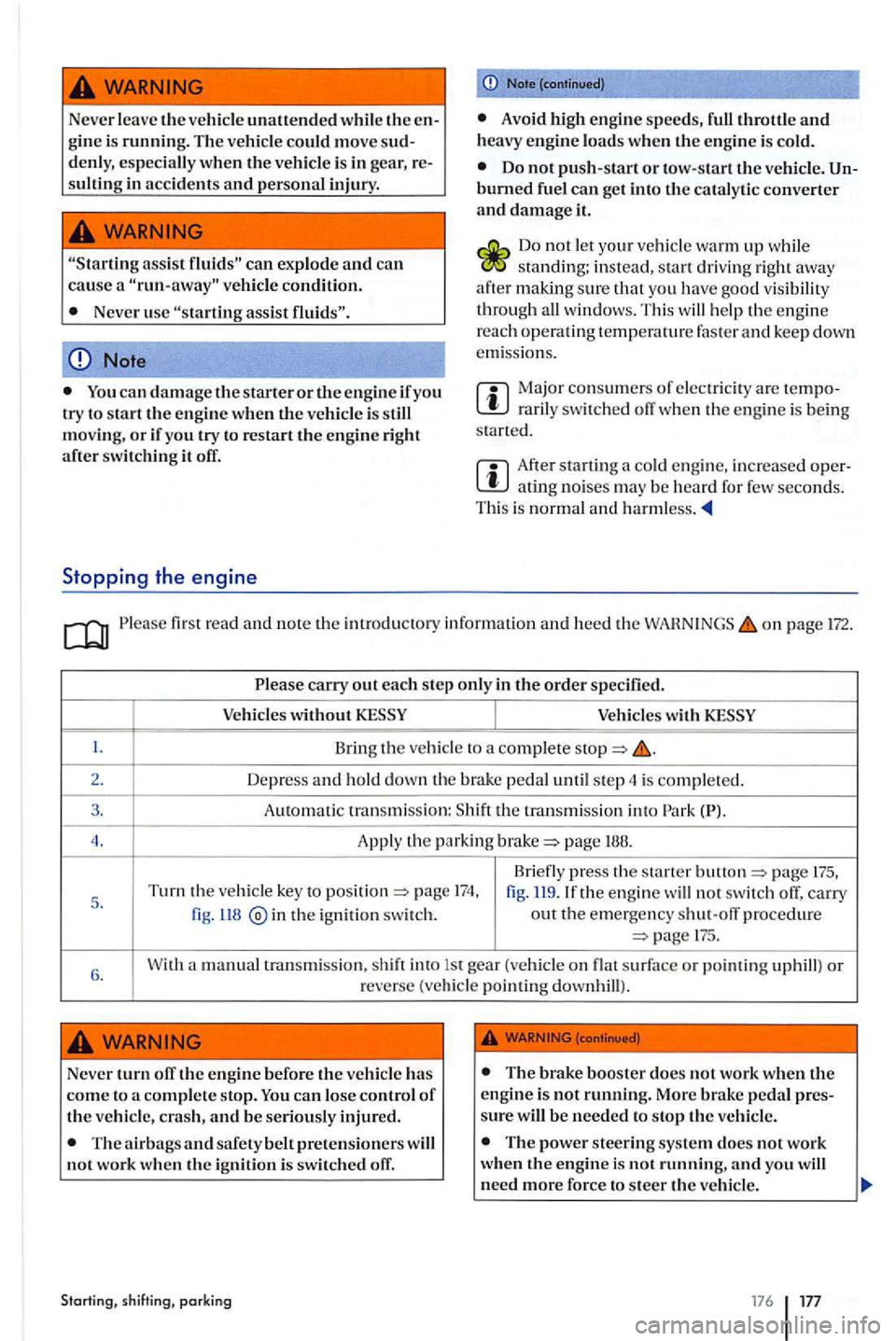
Never leave the vehicl e unattend ed w hil e th e e ngin e is running . The ve hicle could move sud
d enl y, es peci ally w hen th e vehicl e is in gear, re
s ultin g in accide nts and personal injury.
assis t ca n ex plode and ca n
ca use a ve hicle condition.
Neve r u se
Note
Yo u can damage the s tarter o r vehicl e is still
mo vin g, or if you try to res ta rt
Not e (c onti nued)
Avoid high en gin e sp ee ds, full throttl e and heavy en gin e lo ads wh en th e eng in e is cold.
D o n ot push-sta rt or tow-start the ve hicl e. Un
burne d fuel can ge t int o the cataly tic convert er
and damag e it.
Do not let yo ur vehicle warm up whil e sta nding; ins tead, sta rt driving right away
after makin g sure th at you have good vis ibil ity
t hrou g h all windows. This will he lp th e e ngin e
reach operating temperature fas ter an d keep down
emiss io ns.
Majo r consu mers of e lectricity are te mporarily swi tc hed off when th e e ng in e is bei ng
s tarted .
After starting cold engin e, increased operating nois es may be heard f or f ew seconds.
Thi s is no rmal and
firs t r ead an d note th e intro ductory in fo rm atio n an d heed th e page 172.
Pl
ease car ry out each ste p onl y in the order sp ecified .
Vehicl es with out
Bring th e veh icle to a co mplete
2. Depress an d hold down th e brake pedal until step 4 i s co mpleted.
3 . A uto matic tra nsm ission: Shif t the tra nsmiss io n in to Park (P).
4 .
Apply the parking page
pag e 175,
5. Turn th e vehicle key to pag e fig. 119. th e ignitio n sw itch. out the emergency sh ut -offproc edure
6. W ith a manual tra nsmiss ion, sh ift in to Ist gear (vehicle on fla t surfa ce or p ointing uphill ) or reve rse (vehicle pointing downhill ).
N ever turn off the e ngin e before th e ve hicle has come to
T he a irbags and safe ty belt prete nsio ners w ill not work when th e ig nition is swit ch ed off .
Starting, parking 176 177
Page 180 of 541
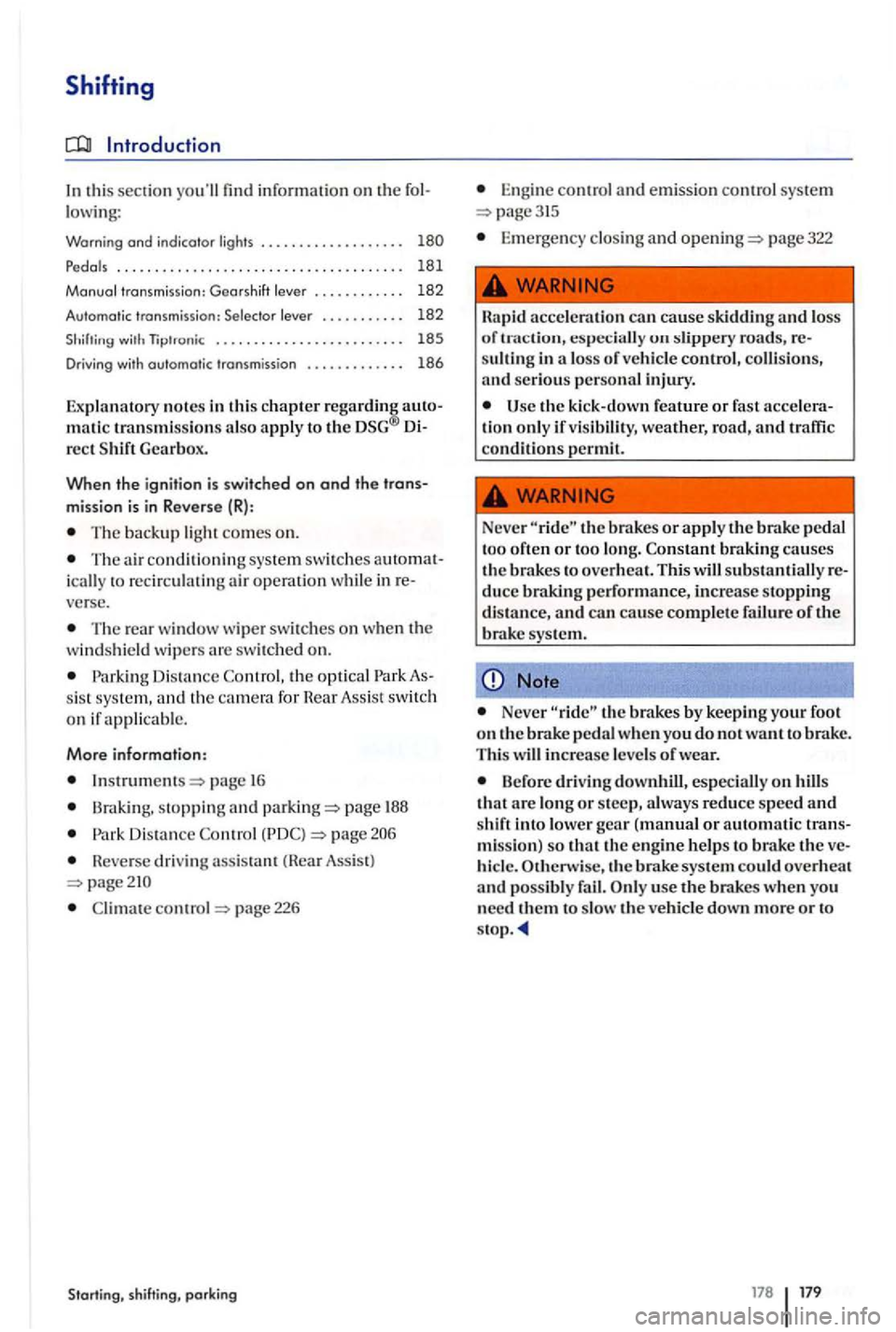
Shifting
Introduction
In this section you'll find information on
. . . . . . . .
Pedals . . . . . . . . . . . . . . . . . . . . . . . . . . . . . . . . . . . . . . 181
Manual transmi ssion: Gearshift lever . . . . . . . . . . . . 182
Automa tic transmission: Selector lever . . . . . . . . . . . 182
with Tiptronic . . . . . . . . . . . . . . . . . . . . . . . . . 185
Driving with automatic transmission . . . . . . . . . . . . . 186
E xplanatory no tes in thi s chapter also apply rect Gearbox.
When the ignition is switched on and th e
T he backup light comes on.
Th e air co nd itionin g sys te m sw itch es ically r ecirculat ing air verse.
The rear window wiper swi tches on when
sis t sys te m , a nd camera For
Instrum em s
Brak ing, and
D is tance
H everse driving assista nl (Rea r Assist)
Clima te comrol
Eng in e contro l and emission cont rol sys tem
Eme rgen cy closi ng and page 322
accelera tion can cause skidding and loss of t ract ion, especially on slipp ery roads, sulling in loss of vehicl e control , collision s,
and seriou s personal injury.
kick -d own feature or fast ti on onl y if vis ibility, weather, road , and traffi c
co nditi ons permit.
Neve r
or apply the p edal often or lo ng. Constant brakin g ca uses the brakes to over hea t. This subs ta nti ally duce performance, increase stop1> ing
d is tance, and cau se complete failure of th e
Note
Neve r the brakes by keeping your foot
o n brake ped al when you do not want to brake.
Thi s
Before driving downhill , es peci all y on that are lon g or steep, alw ays reduce speed an d into lower gear (manual or auto mati c mission) so that th e engin e help s to brake hi cle. Otherwi se, th e brake system could over hea t and possibl y fail. use th e when yo u
n eed them slow v ehicl e dow n more or
Page 200 of 541
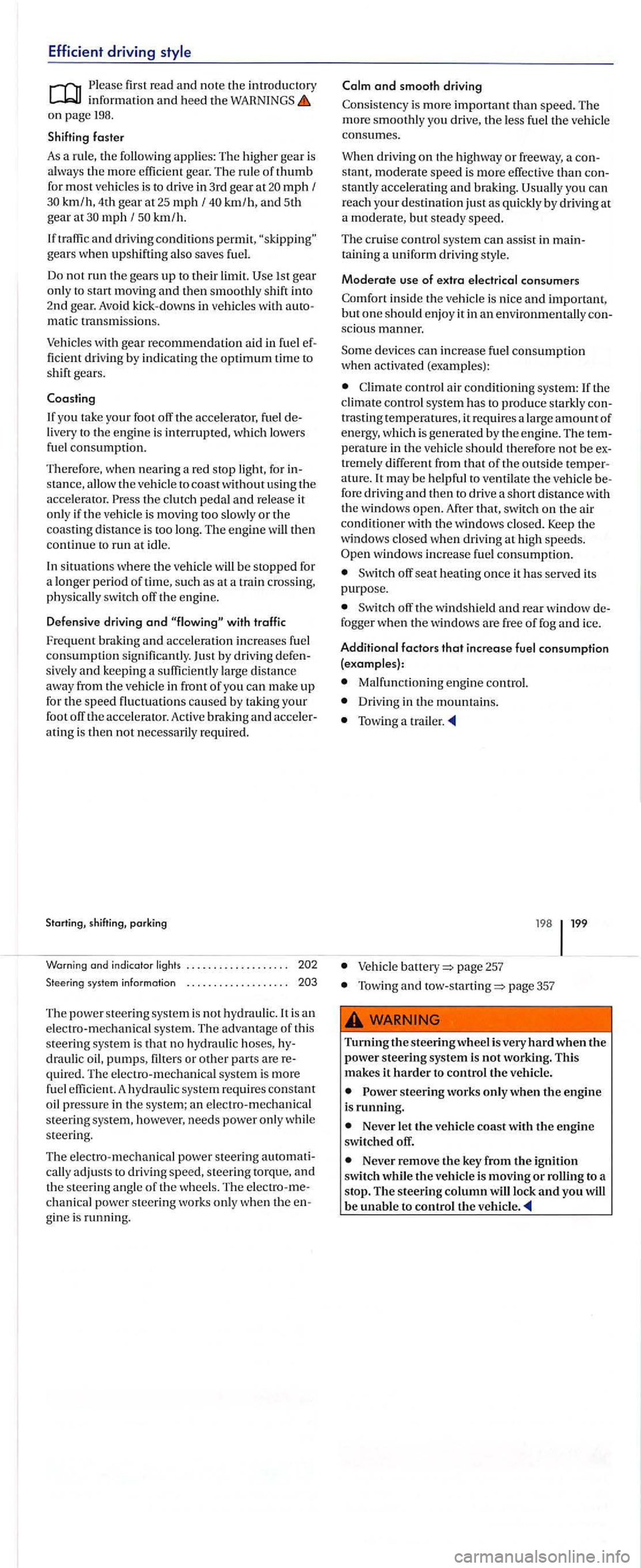
Efficient driving
Please information and heed the on page 198.
Shifting faster
As a rule, the following applies: The higher gear is
a lways the more efficient gear. The rule of thumb for most vehicles is to drive in 3rd gear at mph f km/h, 4th gear at 25 mph f km/h, and 5th gear at mph f km /h.
If
and driving conditions permit, gears when upshifting also saves fuel.
Do
not run the gears up to their limit.
mati c transmissions .
Vehicles with gear recommendation aid in fuel fic ient dri ving by indicating the optimum time to shift gears.
livery to the engine is interrupted, which lowers
fuel consumption.
T herefore, when nearing a red stop light , for s tanc e, allow the vehicle to coast without using the accelera tor. Press the clutch pedal and release it only if the v ehicle is moving too slowly or the coasting distance is too long. The engine will then continue to run at idl e.
In situati ons
where the vehicle will be stopped for
a longer period of time, such as at a train cros sing,
physically switch off the engin e.
D efens ive driving
and with traffic
Fre
quent braking and accel eration increases fuel consumption sign ific antly. Just by driving sivel y and keeping a su fficiently large distance away fro m the vehicle in front of you can make up for the speed fluctuation s caused by taking your foot off the accelerator. Active braking and ating is then not necessarily required.
system information
The power stee ring syste m i s not hydrauli c.lt is an electro-mechanical syste m. The advantage of this
s te ering system is tha t no hydra uli c hoses, draulic oil, pumps, filters or other parts are quired . Th e e lectro-m echanica l system is more fue l effi cient. A hydraulic system requires constant oil pressure in the syste m; an electro -mechanical
s teerin g sys tem, however, needs power only whil e
s teering.
Th e el
ectro-mechanical power steering
chanical power steering works only when the gin e is running.
and smooth driving
Consistency is more important than speed. The more smoothly yo u drive, the less fuel the vehicle consumes.
When driving on the highwa y or freeway, a
stantly accelerating and braking. you can r each your destinatio n just as quickly by driving at a moderate, but steady speed.
The c rui se control syste m can a ssis t in
sciou s manner.
Some dev ices can increase fuel consumption when activated (examples):
C limate control air conditioning system:
trasting temperatures, it requires a large amount of energy, which is generated by the e ngin e. T he
tr emely different from that of the outside
windows increase fuel consumption.
Switch off seat heating once it has served its
purpose.
Sw itch off the windshield and rear window
Malfunctioning engine control.
Driving in the mountains.
Towing a trailer .
page 257
Towing and page 357
Turning the steering wheel is very hard when the power steering system is not working. This makes it harder to control the vehicle.
steering works only when the engine is running.
Never let the vehicle coast with the engine switched off.
Never remove the key from the ignition
switch while the vehicle is moving or rolling to a
stop. The steering column will lock and you will be unable to control the vehicle.
Page 223 of 541

In thi s section you'll find information on th e followi ng:
C o
ntrols ................................... .
Heating system operation
Air conditioner operation .. .................. .
Air vents .... .............................. .
Air recirculotion
and
228
23 1
232
232
ve hicle is equipped e ith er with a Climatic cli
mate co ntrol system or with a Climatronic climate co ntrol sys tem. ve hicles w ith tron ic clim ate co ntrol, syste m statu s m ess ages will appear
Volkswa gen Informa tion page
Windshi eld w iper and pag e
Exterior care an d page 262
increases th e risk of and other acci de nt s that cause seri ous pe rso nal in
jurie s.
Always make sure all win dow s are clea r of ice , s now and condensa tion fo r good visibil ity to the front, si des, and rear.
Maximum heatin g output and defrost ing
w ill only be possi ble after th e engine yo u
h ave good visibili ty before driving off.
Alwa ys make sure yo u know how to properl y
u se t he heating and ve ntilation syste m s as well as the rear window defogger that yo u will nee d
for goo d visibility.
While driving
Neve r use air recircu lation for lo ng peri ods of time. W hen the air conditioner is off and r ecirculation mode is on, co ndensation ca n qui ckly
form on th e windows an d great ly reduce visi
bility.
A lways switch off reci rculati on mode w he n it
i s not n eeded.
air causes d ri ve r fatigu e and reduces drive r alertness, w hich can cause accidents, collisions and seriou s personal injury.
Never swi tc h off the fa n for a lo ng pe riod of lim e and never use air reci rc ulation a lo ng pe
r iod of time because no fresh air will co me into
th e passe nger compartment.
Note
th e a ir conditioner
checked by an authorize d Volk swage n dealer or authorized Volkswage n Servic e Facility.
Air conditi oner repair requires speciali zed
kn ow le d ge and special tool s. Volkswagen recom
m ends that you sec an authorized Volkswagen
dealer or authorized Vol kswagen Service Facility.
Do no t smoke whe n air reci rc ulati on is
sw itched on. drawn int o th e ve ntilation
syste m can leave residue on th e e vaporator an d
on th e dust a n d pollen active carbon re
su ltin g in permanent odors when ever the air con
ditione r i s switched o n.
out side air no t b e dehumidified. To keep the windows from fogging over, Volk swage n rec
omme nd s leavi ng th e air conditioner (co m
pre sso r) switc hed on. button. The in-
dica tor light in the bunon mu st come on.
Page 226 of 541
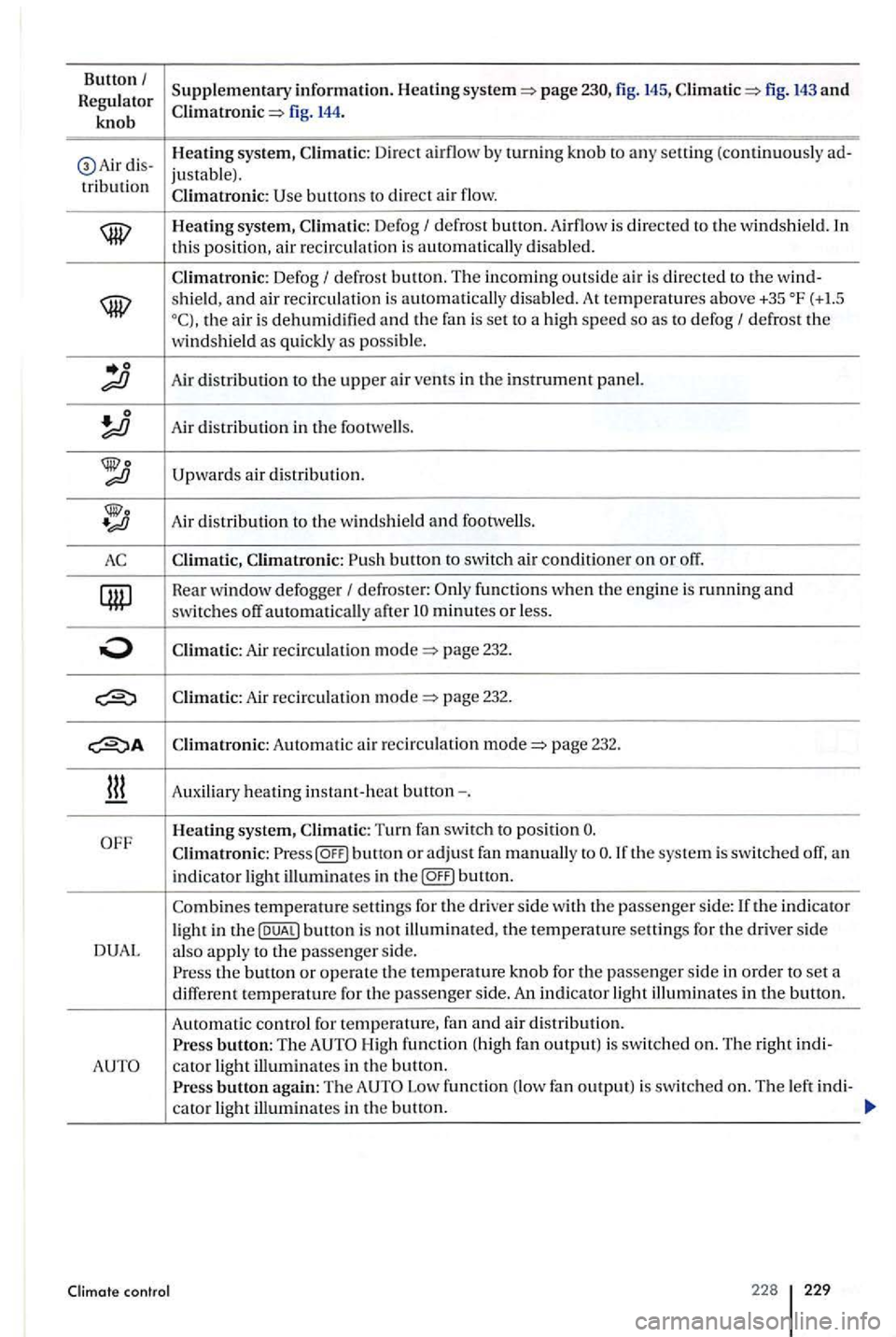
Button/ Supplementary information. Heating page 230, fig. 145, fig . 143 and Regulator knob fig . 144.
Air dis - H
eating system,
bullons to direct air flow.
Defog I defrost button. Airflow is directed to th e windshi eld . this position, air re cir culation is a utoma tically disab le d .
C limatronic: Defog
I defrost bulton. T he incomin g outsid e a ir is directed to the w ind-shie ld , and air recirculation is automatica lly disab le d. A t temperatures above +35 (+1.5 the air i s dehumidified and the fa n i s set to a hig h speed so as to defog I defrost the windshield as quickly as possible .
Air distribution to the upper a ir ve nts in the instrument panel.
A ir distribution in th e footw ells.
A ir distribution to the windsh ie ld and footwells.
bullon to swit ch air conditi oner o n or off.
Rear window defogger I defro ste r: fun ction s when the engine is nmning and switches off automatically after
Air rec ircu lation page 232.
Air r eci rc u lation page 232.
Climatron ic: Auto mati c air recircu lation page 232.
Auxil iary heating insta nt -h eat button-.
Heating system, Turn fan switch to position
or adj ust fan manually to the system is swit ched off, an
indi cator light ill
uminates i n th e button.
th e indicator
ligh t in th e butto n is no t illum in a te d, the tempera ture se11ings for the driver side a ls o apply to th e passenger side. th e button or operate th e temperature knob fo r the passenge r side in order to set a
differ ent temperature for the passenger sid e. An ind ica tor light illuminates in the button.
A
utomatic control for tempe rature, fa n and air distributi on. button: The High function (hi gh fan output) is switch ed on. The right indi -cator ligh t illuminat es in the b utton. button again: The
Page 228 of 541

Air conditioner operation
information and heed the WAHNINGS on page 226.
The cooling syste m for the passenger compart
ment o nl y functions when the engin e is running
and the fan is switched on.
The air conditioner is most efficient when the w indows an d the power sunroof are closed. However,
if th e vehicle is sta ti o nary and the passenger compartment becomes very hot due to sunlight, opening the w indows briefly may speed up the cooling proce ss.
Keep
the a ir intake slot in front of the windshield
free of i ce, snow and lea ves in order to maintain proper funct ioning of the heating and ventilation systems.
Settings for optimal driving safety
When yo u sw itch on the cooling system, both the temperature and humidity in the vehicle are reduced. Th is will help make passengers feel more comfo rtable and prevent windows from fogging
up.
For
Sw itch off a ir page 232.
fan to Ievell or 2.
T urn the temperature knob to t he center posi
tion.
all air vents in the in strument panel page232 .
Turn the air distribution knob to the des ired settin g.
butto n to turn on the air conditioner. The indicator light illumin ate s in the button.
For
th e button.
temperature to +72
pa ge232.
Sw itching between Fahrenheit and Celsius in Cli
matronic
The t empe ratu re disp lay is switched from to Fahrenheit and vice versa in the display of the factory- in stalled radio or naviga tion system via the in strument cluster page
control
H eating
Maximum heating output and fas t defrosting will
only be possib le a fte r the e ngin e has reached operating tempe rature.
T he e ng in e is not running.
T he fan is switc hed off.
The a ir conditi one r fuse has blown.
The ambien t a ir temperature is colder than (+3
T he air condition er compresso r has been tem
porarily switched off due to excess ive engin e coolant temperature.
The re is a nother malfunction in the ve hicle.
Ha ve the ai r conditioner checked by an authorize d
Volkswage n dealer or authorized Volkswage n Ser
v ice Facility.
Special considerations
Whe n it is very hot and humid outside, water con
d ensation can drip from the air condition er evaporator and form
The air condit ioner takes a few minutes to reach the selected temperature in the passenger compartment.
Due to residual m oisture in the air condi tione r, th e windshi eld may fog up after the
engi ne is s tarted.
23 1
Page 259 of 541
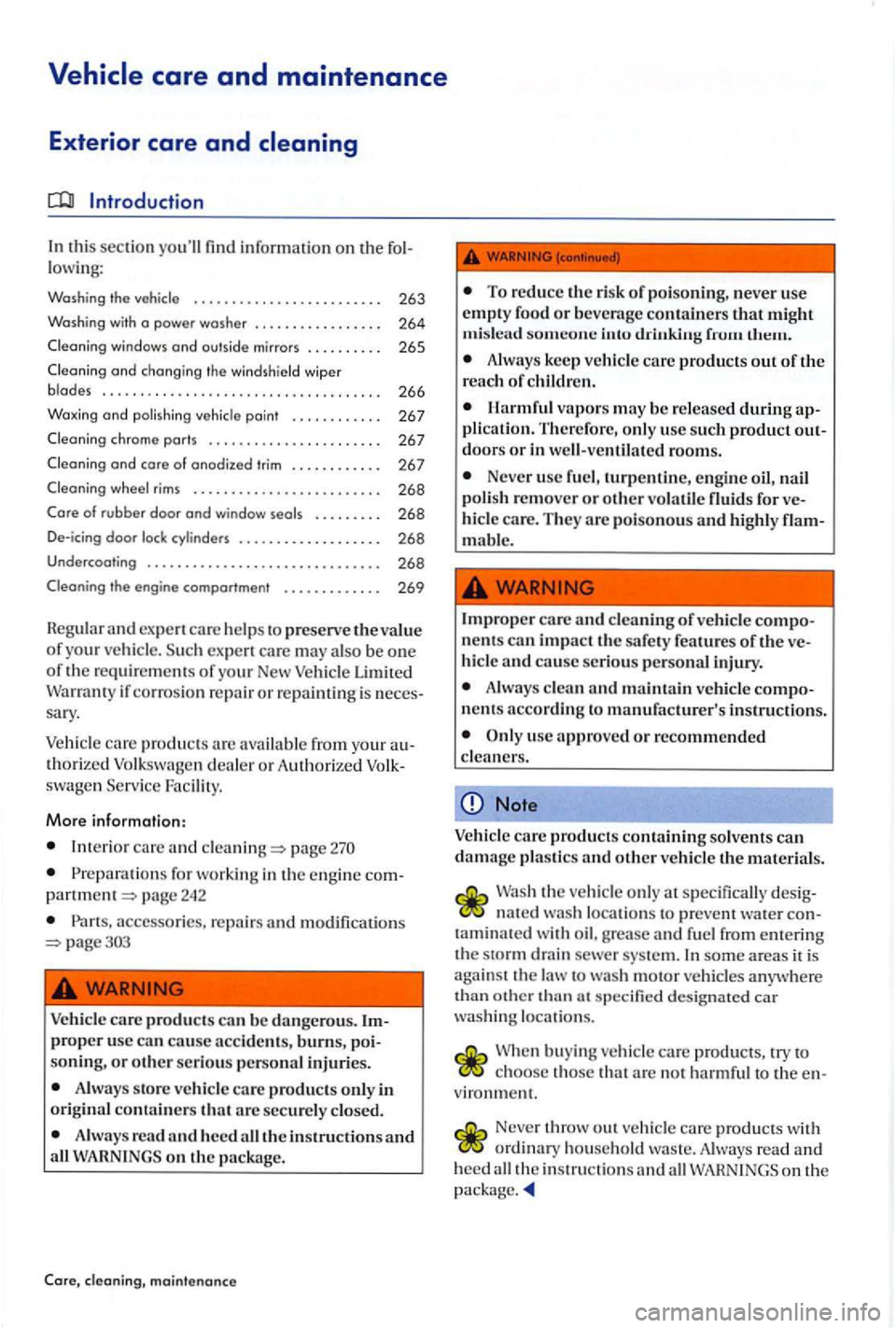
In this section information on th e fol
l owing:
Washing the vehicle . . . . . . . . . . . . . . . . . . . . . . . . . 263
Washing with a power washer ................ .
Cleaning windows
and outside mirrors ......... .
Cleaning
and changing the winds hield wiper
b l
ades .......................
. . . . . . . 267
Cleaning wheel rims . . . . . . . . . . . . . . . . . . . . . . . . . 268
Care of rubber door and window seals . . . . . . . . . 268
De-icing door lock cylinders . . . . . . . . . . . . . . . . . . . 268
Undercoating . . . . . . . . . . . . . . . . . . . . . . . . . . . . . . . 268
Cleaning the engine comportment ....... -. . . . . 269
Regu l
ar and expert ca re helps to preserve the value of your vehicle. expert care may also be o ne of th e requirements of you r New Vehicle Lim ited if co rros ion re pair or repa intin g is neces
s ary.
Veh icle care produc ts avai lable fro m your au
th orized Volkswagen d eale r or A uthorized
Int erio r care and page
Preparations for work ing in the e ngine compage 242
Parts. accessorie s. repair s and modifications
Vehicle care produc ts ca n be dangerous. Im
proper usc c a n cause accid ents, burns, poisonin g, or oth er seri ous persona l injuries.
Alway s sto re vehicle care products only in o rigina l co ntainers that are securely closed.
Alway s read and heed all th e in structions and all o n the pac kag e.
To reduce the risk of poiso ning, never usc empty food or beverage containers that might m is lead someone int o frum
A lways keep vehicl e ca re products out of the reach of childre n .
Never usc fuel, turpentine, eng in e o il, nail poli sh r emov er or ot her vo la til e fluid s for ve
hicl e ca re. They are po isonous and hi ghl y flam
mable.
Improper care and cleaning of ve hicl e component s can impact the safe ty feature s of the ve
hicl e and cause serio us personal injury.
A lways clea n and maintain vehicl e component s according to manufacturer's instructions.
use ap1>roved or recomm ended
clean ers.
Vehi cle care products containing s olvents can damage plastics and other ve hicl e th e material s.
Wash th e ve hicl e only des ig nated was h loca tio ns to preve nt wa ter con
t a minated with oil. grease and fuel from enterin g the storm drain sewe r system. In some are a s it is
a gains t th e to wash motor ve hicles anywhere than other than sp ecified design ated car
was hing locatio n s.
choo se those that are no t harmful to the environ ment.
Never th row out ve hicl e care produ cts with ordina ry house ho ld waste. Always read and hee d all th e in structi ons and on the